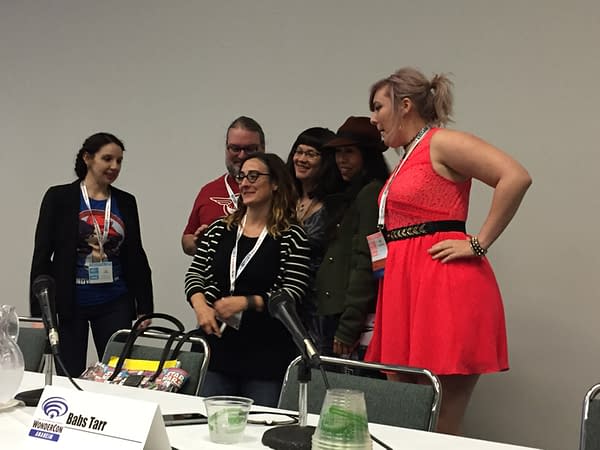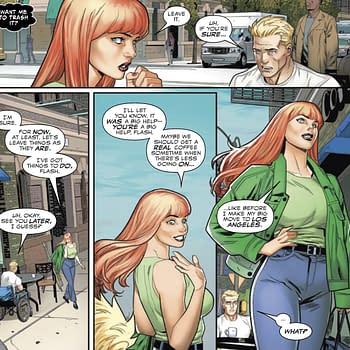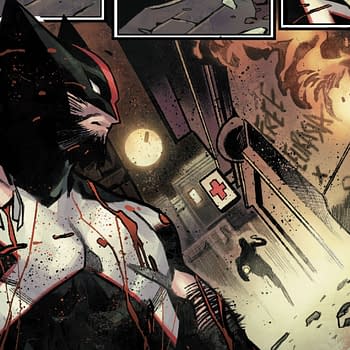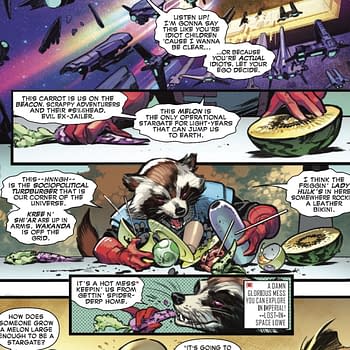Posted in: Comics | Tagged: agent carter, Andrea Letamendi, Babs Tarr, batgirl, Cecil Castellucci, Jose Molina, Sarah Kuhn, wondercon, Wondercon 2015
WonderCon '15 – Agent Carter, Batgirl, And The Making Of The Modern Super Heroine With Babs Tarr, Jose Molina, Cecil Castellucci, Sarah Kuhn, and Dr. Andrea Letamendi

Molina, a TV writer, recently finished writing on Agent Carter. Castellucci writes young adult novels and recently did a Sensation Comics Wonderwoman story. Kuhn is writing a fantasy series about Asian-American superheroines and is writing a romance comic for an anthology. Letamendi is a psychologist, educator, and consultant for creative fiction who speaks at conventions about superheroes and podcasts as well on the psychology of superheroes. Babs Tarr draws Batgirl, if you somehow didn't know that already.
The panelists were asked who a recent heroine in pop culture is who has appealed to them. Tarr said Sailor Moon will always appeal to her, since she got into her when she was around age 14 like Sailor Moon and it encouraged her that Sailor Moon was imperfect. Letamendi cited Ms. Marvel as a recent favorite, not just because it's a great story, but also because she likes the fact that Ms. Marvel doesn't have the typical body expected of a superhero and the story has real-world implications. She also likes The Last Unicorn. Kuhn likes the mother on Fresh Off The Boat and appreciates characters who are unstoppable and have core traits that we usually see expressed in male protagonists as female protagonists. Castellucci's icon will always be Lois Lane. Also, Michonne and Carol from The Walking Dead as characters who have "persistent growth" and emotional growth as well. Molina's first answer was, of course, Peggy Carter. He "couldn't love that character more", he said. He also likes the women of Mockinjay, who perform difficult jobs who ground their world and make it relatable.

Kuhn spoke about making female characters who are not perfect, or always likeable. She reflected on Nancy Drew, who didn't really have a personality, except she was the best at everything she did, including figure skating, which didn't make sense. As a writer, she "actively works against that" and has to pull back so as not to make characters too unlikeable. She draws on her own imperfections and strident opinions on things like the X-Men to create obsessive characters. With licensed characters there's a huge legacy of female superheroes, Kuhn said, and so when she's creating a new female hero, she has to think of a way to make the story interesting and personal, and perhaps gives them unusual powers more associated with villains to shake things up.
Molina was asked what conversations came up in the writers' room about making Peggy Carter relatable. Molina said that we have some history with Peggy due to the two Captain America so we know her heart and world-view, so they focused on telling the best story they could about this "person" and not just this "woman". So they made sure she had friends, a non-sexual relationship with a male, and other interesting relationships in the story. Castellucci commented that the show also points out the constraints of the time period and her forward thinking personality which clashes with her world. Molina said that "guy writers" still see women trying to succeed in a world that's not always welcoming to them, so they tried to be smarter and "more inventive" of how she gets around people. Sometimes Carter plays on peoples' weaknesses, lies, or uses assumptions about her female role against people. They "tried to represent things we'd seen", Molina said, and looked to two female showrunners on the show as examples, and the ways in which they'd had to be "smarter" and more driven than those around them to succeed because of their gender.

Tarr was asked about the costume redesign for Batgirl. She said that Cameron Stewart had wanted Batgirl's costume to be redesigned from the beginning, as well as moving her out of Gotham to Burnside so she could "be her own person". Stewart already had boots and a jacket in mind. She changed an "old school belt" and added a thigh-strap. She changed her hair from being up to being down, and for the first time, her ears were visible, so she could add earings. Each of the girls in the book are "dressed in ways that reflect their personality", Tarr said. Tarr pointed out that Batgirl didn't get her teen years, and is a little bit "tomboy" in style, avoiding tight clothes.
Letamendi said that all of these details are "important" to exploring identity through clothing. Those "subtle choices" are important for characters who are loved and who influence readers. It suggests "personality, resiilency, starting anew, and overcoming", Letamendi said, which means it's not superficial. She's telling the world what she wants people to think of her, so it's important, Letamendi said.
Right now, Tarr said, she's trying to slowly work more Librarian style into Barbara's clothing, so she can "grow visually" as she gets older.
Tarr referred to the fashion panel this morning, where the costume for Supergirl was discussed and how the way someone is presented affects the way you "read" the costume. Castellucci agreed that some "femininity" and "sexuality" is appropriate, and removing them might be a problem when trying to develop "fully fledged character".
Letamendi, who was a psychologist in the Batgirl of the New 52, written in as a professional character, said that psychologists aren't "super popular" in superhero comics. Trauma and seeking help usually results in someone becoming a supervillain! Working with Gail Simone, with dialogue between two women, a superhero and a psychologist, was significant. It was handled "very well", Letamendi said, and she "felt honored" to be included.
Molina said that there's progress to the presentation of Agent Carter because sometimes she shows agency by taking advantage of being ignored and underestimated by those around her. Molina said that he wished he could encourage people who had criticisms about Carter to also praise the things they liked about the show when approaching the network, being encouraging rather than "nitpicking" about keeping progressive shows alive. Otherwise the networks only ever hear the negative and don't want to take risks with diverse characters in shows.
Tarr said that after Convergence, fans may see more books like Batgirl. Tarr feels like the only reason they got to do this run on Batgirl was because it was only 6 issues until Convergence. Mark Doyle managed to get those 6 issues because it was a limited experiment and it exploded, so after Convergence, there will now be more "hot stuff" because of Batgirl's success as a book. Support the books that are doing new things, Tarr encouraged, to see more change in the future.

As much as Molina does follow Twitter and social media about reactions to Agent Carter and other things, you can't let peoples' reactions "drive the narrative", he said. Things can't be "always awesome all the time", Tarr agreed. There is pushback, and you have to get "creative" and may end up with a "better ending" because of that. They try to tailor Batgirl to have a grounding in the real world, like addressing "revenge porn" legal issues and put a "superhero spin" to it.
When a fan asked the panelists how they keep modern and relevant and keep up with modern young people, Babs Tarr said, "Well, I am one!" to applause. Molina also said, simply, talk to people from diverse backgrounds and perspectives, in which the internet is a great resource. He often shows scripts to his wife to get a different perspective, too.
















